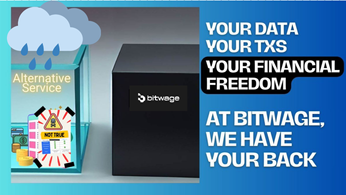
Hiring Remote Workers: Step-by-Step Guide
Discover the benefits of remote work, best practices for hiring remote employees, and how to manage payroll efficiently using Bitwage. Explore tips, tools, and strategies to build a productive and satisfied remote workforce.
Table of Contents
Working remotely has become a staple in our current day and age and the benefits of hiring remote workers are numerous. Remote work is here to stay and will lead the way we work.
While we can't fully say that the COVID-19 pandemic was the only driving factor for remote work becoming a staple, we can say it played a huge part. Businesses were forced to send employees home and find a way for them to do their work remotely. Businesses saw this as an opportunity and a benefit.
Looking to tap into remote work? Or looking to hire remote workers? In this post, we will discuss how you can do so, the best practices, and the different freelance marketplaces where you can find your much-needed talent.
🎯Why Are We Shifting Towards Remote Work
It's simple. Results are more important than time spent.

In recent years many companies have made a permanent shift towards remote work, appreciating the cost savings and the improved productivity remote work offers. Be it a hybrid (Some in-person and some remote) stance or a fully remote stance. FlexJobs, CVS Health, UnitedHealth Group, and Randstad are some of the top companies that have 100% remote workers.
In 2022 alone, a study by Virtual Vocations revealed that the number of workers choosing to work remotely increased by 24%, while interest in working on-site dropped by the same 24%. In the same case study, they mentioned that 58% of employed workers in the U.S. can work remotely at least part of their time and approximately 77% of professionals in the digital fields like computers and math can work from home 100% of their time.
So undoubtedly employees are more keen on working remotely than they were in the past. Employers should also catch up and enjoy the benefits of having a remote workforce.
🎯Why Hire Remotely

While there is absolutely nothing wrong with hiring localized workers, remote hiring offers significant benefits, such as accessing diverse talent pools and finding global talent for remote positions Let's dive in and check out some of those benefits.
Cost Efficiency
One of, if not, the most significant benefits of hiring remote employees is cost savings, which includes reduced office expenses and the overall cost savings with remote work. Companies, businesses, and employers can save on expenses related to renting office space, utilities, maintenance, office supplies, and much more. Remote work also eliminates the cost associated with relocation or daily commuting expenses for employees.
Access To Global Talent
Ever need to find specialized talent only to find that there are none near your business? Hiring remotely allows companies to tap into a global pool of talent. So you no longer need to choose between a pool of local candidates for a job that may not 100% suit them and then later have to give them more training or waste time and money on making them study that specific field you want them to work at. Instead, you can find that one individual who is perfect for the job, even if they live on a remote island in the middle of the Pacific Ocean.
Environmental Benefits
While this is often overlooked, in the world we live in, we are constantly destroying our environment, especially for large companies with a big workforce. Removing work can drastically reduce the carbon footprint of a company or enterprise. With fewer employees commuting, there is a significant reduction in greenhouse gas emissions, while also decreasing the use of office resources such as paper and electricity. Not only do you lower the environmental impact, but by hiring remote workers you also reduce expenses on office supplies.
Health and Well-being of Your Employees
Remote work can lead to improved mental health of your employees. While balancing a good work-life relationship for remote workers can be quite a challenge, without the stress of commuting and with more control of their work environment, employees usually find that they have lower levels of stress while working remotely, which leads to higher levels of overall well-being.
🎯Steps To Take Before Hiring
While it can seem pretty straightforward, hiring remotely has its trickery. To ensure a successful process and outcome there are a few factors to keep in mind.
Let's go over them.
Prepare for Remote Onboarding

Developing a comprehensive remove onboarding process is a great place to start. Include digital contracts, and tutorials for the software you use, have a specific place for communications, and help new hires integrate into the company's culture. Another great idea is to hire a "Head of Remote". It may be beneficial to hire a dedicated individual to oversee the unique needs and requirements while also ensuring that they are integrated and have a specific individual that supports them within the organization.
Define Clear Expectations and Job Roles
The first step would be to detail the job description. This includes outlining the responsibilities (due dates, tasks at hand, how communication will take place, etc). After the job description is clearly outlined, it is good practice to include the required skills needed for the task. This is very dependent on the job at hand but it can be anything from Google tool knowledge to a specific language the possible employee must master for clear communication. Adding the performance metrics that the employee must track, measure, and grow is also super important to include.
Screening your candidates for remote work skills can give you the upper hand and save you headaches. Remote work requires certain skills, such as self-motivation, time management, and work-life balance. It's also important to note if the job requires the candidate to have phone calls, the candidate MUST have a quiet place to work. Assess these abilities when on the interview with your candidate and make questions that revolve around these topics to make sure your possible employee has these skills.
Figure Out Payroll
Before beginning the process of hiring you should figure out payroll. Payroll is how you are going to be paying your employees, be it directly or through a 3rd-party. The most known methods of conducting payroll for remote workers are in-house, outsourced, or hybrid. While there is also a sneaky 4th one we will mention later.
In-House Payroll
In-house payroll means that your own business or company is in charge of paying your employees and processing to the various countries every week, biweekly, or every month, depending on what you arranged. This method is the most common and mostly used, even though it can mean a ton of work for your internal team, especially when considering international freelancers. Each country may have its own compliance risks, tax system, and minimum wage laws that must be taken into account.
Outsource
Since In-house payroll can be a hefty task when dealing with multiple international workers, most companies opt for outsourcing their payroll to a dedicated team. This can help businesses save time and effort but it can be challenging as well. Before outsourcing, please consider that the payroll provider must be allowed to issue salary payments in the country they are sending to. This can avoid further headaches and possible fees.
Hybrid
This is a great option for companies that want to outsource their payroll but process the payments in-house. This method usually involved dividing payroll between in-house and outsourced. In countries where in-house payroll can be done, they go for in-house, and in countries where laws don't allow you to do it in-house, it is outsourced to a third party. Lots of companies shifting towards a completely remote, or partially remote team opt for this option.
Crypto Payroll
This is a new and innovative approach to payroll that many companies are opting for. At Bitwage we believe in the power of cryptocurrencies and their decentralized and border-agnostic nature to empower payroll for companies. Cryptocurrencies are by nature, faster, cheaper, secure, transparent, and have a global reach. This means that your payroll can also be faster, cheaper, and more secure while not needing to outsource your payroll in countries where your in-house payroll does not apply. Since this is a rather new way of conducting payroll let's dig a bit deeper into some of the benefits of crypto payroll for employers and employees.

Cost Savings
- Lower Transactions Fees: Cryptocurrency, be it Bitcoin, Ethereum, or stablecoins that are pegged 1:1 to their fiat counterparts like USDC or USDT often come with lower fees when compared to traditional banking and international wire transfers.
- Currency Conversion: When paying overseas, currency conversion is a thing. So you may send $100 USD but after currency conversions, your employee received only $87. Why is that? This is called currency conversion and it is associated with traditional international payments. When using cryptocurrencies, you can assure your employees that they will receive the correct amount without any deductions or currency conversion costs.
Faster Payment Processing
- Immediate Transactions: Most cryptocurrencies can be transferred almost instantly. Forget about long wait times to receive a paycheck. This helps employees and employers. Employees get their wages promptly while employers keep their employees happy. A win-win scenario. This is particularly beneficial for cross-border or international payments.
Global Reach and Accessibility
- Access To A Global Workforce: One of the biggest things about cryptocurrency is that it's available to anyone across the globe, all you need is an internet connection. This allows businesses to pay employees all over the world without the hassle of currency differences and or relying on their local banking services. Which also allows you to include employees in countries with less developed banking infrastructure.
🎯Where to Find Remote Workers
You made it this far! Congrats. Now that you found out about remote work, the benefits, figured out the steps to take before starting your search, and figured out what you're going to do about payroll. Let's talk about another important step. Where to find remote workers?
Most remote workers offer their services through a website, a blog, or through social media. These top-tier workers often like to use these mediums to highlight their work, their past achievements, their experience, customer feedback, pricing, and what services they have to offer. Yet several freelancers also use other more traditional means. Let's go over some of those mediums where you will find freelancers.
Job Boards
Lately, most, if not all remote workers, want to make their services available to everyone across the globe. This is where job boards come in. If this is your first time recruiting remote talent, putting your offering on a job board will allow you to get plenty of hits, but this can also be a burden. Since the job offering is available to so many people, you will probably get over 30-40 possible candidates. This can be a tough task and will for sure take you plenty of time. That's why it's important to define clear expectations and job roles before starting to search for top-quality talent.
There are plenty of job boards out there, and some of the most known are UpWork, ZipRecruiter, Indeed, and Glassdoor. If your goal is to get to as many possible candidates as possible, consider posting on all of these, but do bear in mind that this could be a hassle. Creating specific emails and using alternative phone numbers for this purpose is also seen as good practice. There are plenty of spammers on the internet, make sure you don't use a number or account that is important to you.
Social Media
Social media is great for finding freelancers. While websites and blogs are still the main means for most freelancers, some like to showcase their work on social media. Instagram has been blowing up in popularity among freelancer photographers since the platform and its marketing catered to a more visual audience. Many freelancers will offer their services on Instagram. In the same fashion, Pinterest is catered to designers and artists, so there is a high chance you will find freelancers offering graphic, artistic, and crafting services on Pinterest. Facebook is a great place as well, freelancers often showcase their skills and the companies they have worked for on Facebook.
This method works great for companies looking to hire remote workers since you can directly reach out to these freelancers through their inboxes or social media pages. This usually comes with a price though. If you are trying to find that one Tiktoker who makes TikToks about craft beer to showcase your beer business, you are going to pay top dollar. Make sure it's worth it.
🎯How to Hire a Remote Worker
We finally made it to the last step! Let's go through all the steps needed to successfully hire your first remote worker.

Create a job description
While you have already somewhat created a job description in the initial steps of this post. Let's make sure the description fits the task at hand. Job descriptions allow you to explicitly explain and express the job role, and what skills and talents are needed. You want to keep this short and sweet and make sure to include:
- A Great Title
- Required skills for the job
- What your company is about
- Responsibilities
- Best means of contact
There is a really good article by UpWork on how to write a successful description worth checking out.
Create your job posting
Choose where and how you are going to look for freelancers. If it's on a job board make sure you can include all the elements you want to outline so you don't get spammed with plenty of candidates that match the job description. If you are opting for a more active approach, create an email or a pitch message to send to your potential candidates. Just like the job description, make sure you cover the key points.
Review and Select
Once the candidates and their resumes start stacking, comes the hard part. Reviewing them and choosing the best candidate. From the get-go, you are going to feel extremely overwhelmed by the amount of applicants and resumes you receive if you are using a job board. The best place to start is to quickly glance and remove the applications that either don't apply to the job description or accidentally send you an application.

After you remove the ones that don't apply, move to sorting and matching candidates in terms of skill and how fit they are with your company's culture. Be sure to look out for remote workers who have these qualities:
- Self Confidence
- Good common sense.
- Willingness to learn.
- Experience in similar positions
- The ability to get results.
This is a baseline and for some specific fields of work there are other traits to take into account, so don't limit to these and add traits as you see fit.
Schedule an interview and assess
The next step is to interview the candidates you see most fit, get a feel for them, and assess their capabilities.
The best way to set up an interview is through a video call. There are many video platforms for conferencing available that you can use to have this video call. Some of the most known and used are Zoom and Google Meets.
Once the interview begins, the interview should be conducted as with any employee. You want to be sure that the candidate has the skills for the gig. Remote workers unlike in-house workers must have an extra set of skills that are often overlooked. Ask them things like:
- Have you worked remotely before?
- How long have you been working remotely?
- What are the most common problems you have with working remotely?
- Tell me about a previous experience where you had an issue with X or Y, how did you overcome the situation?
- How do you handle communication in a remote environment?
Check for References
Once you have interviewed your potential new workers, it is important to check for references. Most of the time, freelancers tend to give you references, yet sometimes they do not. In this case, they do not give you references, check out social media, google their name, and try to find out more information about the person. References can help you correctly solidify what the candidate said during the interview and give you more insights.
Send the Candidate a Job Offering
You have chosen your candidate, and are ready to onboard him into your company. Now it's time to set up a contract. Make sure the contract includes, compensation, the task at hand, the project they will be working on, and means of payment.
Give the person up to a week to respond. They will either not respond or respond with 2 possible answers, a counter-offer or a thumbs-up. Negotiate with your candidate find a good middle ground for both parties and sign the contract.
This final step is the fruit of all the hard work you've done to find that one perfect talent for your company. It may seem like a lot, but once you've done it a few times you will get used to it and find it rather simple.
🎯Conclusion
Thank you for making it this far, you now know that remote work offers numerous advantages, from accessing global talent and reducing costs to improving employee well-being and minimizing environmental impact. To maximize these benefits, it's essential to implement effective hiring practices, clear job descriptions, and efficient payroll management as you have read in this post.
Bitwage simplifies payroll for remote teams by offering cryptocurrency payment options, ensuring fast, secure, and cost-effective transactions without hassle. By leveraging Bitwage, businesses can enhance employee satisfaction while making payroll a breeze.
Embrace remote work strategies to stay competitive and build a thriving, productive workforce. With the right tools and practices, your business can fully enjoy the benefits of a remote team.











